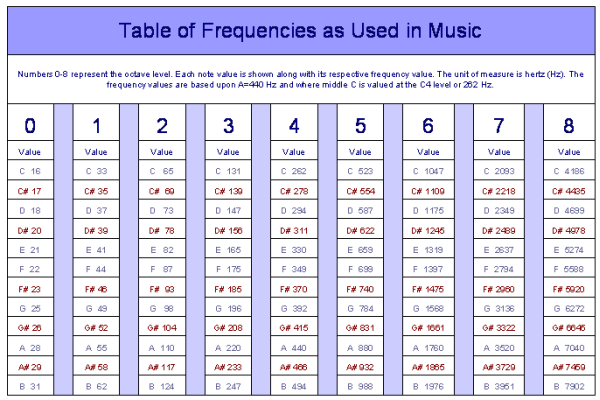

#Octave frequencies iso#
There are two ISO and ANSI approved ways in which the exact centre frequencies may be found. Viola & tenor banjo strings are C3=130.8Hz, G3=196Hz, D4=293.7Hz, A4=440HzĬello strings are C2=65.41Hz, G2=98Hz, D3=146.8Hz, A3=220Hzīear in mind that everything here is in relation to the even tempered (aka equal tempered) scale, where an octave is a frequency ratio of exactly two and a semitone is a frequency ratio of exactly the twelfth root of two. The basis of audio fractional octave bands is a frequency of 1000Hz. The second method for calculating note frequencies is using the octave scale where there are twelve notes per octave, which range from 200-2000 Hz. The first is by counting and dividing the number in Hertz (Hz) from 1200, this would be written as 1200 Hz or 1200. Guitar strings are E2=82.41Hz, A2=110Hz, D3=146.8Hz, G3=196Hz, B3=246.9Hz, E4=329.6Hzīass strings are (5th string) B0=30.87Hz, (4th string) E1=41.20Hz, A1=55Hz, D2=73.42Hz, G2=98Hz There are two ways to calculate the note frequency of a note. At lower frequencies, the ear can more easily distinguish between frequencies.

1 An alternative (unambiguous) term for one tenth of a decade is a decidecade.
#Octave frequencies mac#
Playing notes may not work on Safari on the Mac, though Firefox or Chrome on the Mac is ok. A one-third octave is a logarithmic unit of frequency ratio equal to either one third of an octave (1200/3 400 cents: major third) or one tenth of a decade (3986.31/10 398.631 cents: M3 Play (helpinfo) ). It can also play the notes, so is useful as a tuning note reference. The exact and nominal frequencies are output in arrays. Each semitone therefore has a ratio of 21/12 (approximately 1.059). This program calculates the 1/N-octave-band center and edge frequencies from minf to maxf (Hz). The octave number is in the left column so to find the frequency of middle C which is C4, look down the "C" column til you get to the "4" row : so middle C is 261.6 Hz.Ĭourtesy of Colin Crawley which will calculate the frequencies of notes and can handle tunings other than A = 440Hz. An octave is a ratio of 2:1 and, in equal temperament, an octave comprises 12 equal semitones.


 0 kommentar(er)
0 kommentar(er)
